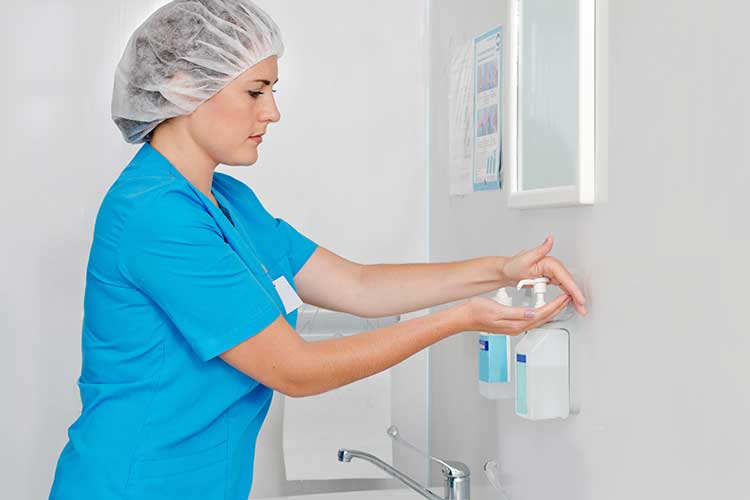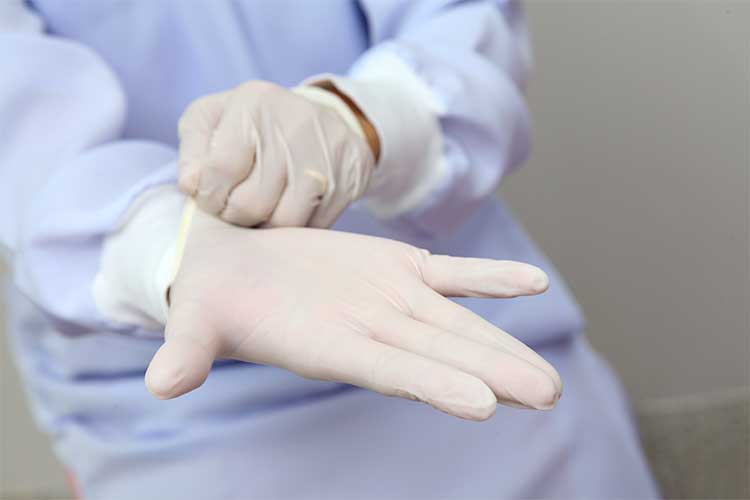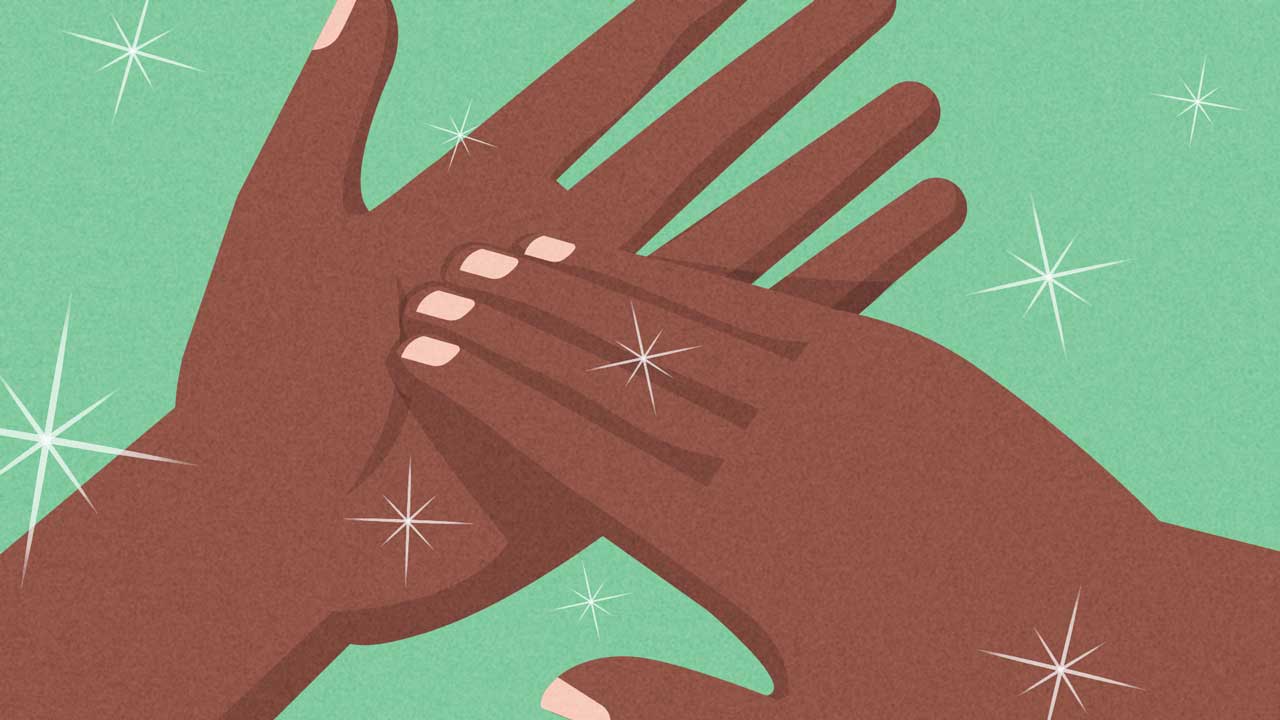Correct and thorough hand hygiene is an essential part of infection control - in fact, it’s considered to be one of the most important methods of preventing infection (NHMRC 2024).
Please scroll down for two video explanations/demonstrations on how to correctly perform hand hygiene.
Thousands of people around the world die every day from healthcare-associated infections (WHO 2009).
Appropriate and adequate hand hygiene is a crucial prevention technique we can all utilise to reduce the spread of harmful infections and diseases in order to protect ourselves, our families and our clients (WHO 2009).
Why is Hand Hygiene so Important?
Hands are the main way infectious agents are transmitted in healthcare settings (WHO 2009). People collect germs throughout the day as they touch various objects and surfaces, and may then spread these to others, or infect themselves (Mayo Clinic 2024). The process of transmitting infectious agents is called the ‘chain of infection’ (NHMRC 2024).
Proper hand hygiene is effective in breaking the chain of infection, and therefore, reducing the spread of various pathogens. This is especially important in healthcare services as people who are receiving care are often immunocompromised due to illness or surgery (Healthdirect 2023).
Young children and older adults are also generally more vulnerable to infection (Better Health Channel 2021).
When to Perform Hand Hygiene

Effective hand hygiene involves washing your hands at the right time and doing it correctly (WHO 2009).
While it’s impossible to keep your hands completely free of pathogens, hand hygiene helps reduce the likelihood of transmission (Mayo Clinic 2024).
The World Health Organisation’s 5 Moments For Hand Hygiene outlines all of the situations in which healthcare professionals must perform hand hygiene. They are:
- Before touching a patient in any way. For example, before shaking their hand, assisting with personal care, taking observations or administering medications. This is to ensure the patient is protected from any pathogens that might be present on your hands.
- Immediately before performing a procedure, to ensure that no pathogens enter the patient’s body during the procedure.
- Immediately after performing a procedure or after a body fluid exposure risk, as your hands might be contaminated by the patient’s body fluids. Even if you are wearing gloves, you must perform hand hygiene immediately after removing them.
- After touching a patient in any way, to avoid contaminating yourself and the surrounding environment.
- After touching the patient’s surroundings. For example, bed rails, linen, tables and light switches. Even if you didn’t touch the patient themselves, their environment might still be contaminated.
(ACSQHC 2019)
You should also perform hand hygiene:
- Before starting and leaving work
- Before consuming or handling food or drinks
- Before using a computer keyboard, tablet or mobile phone in a clinical area
- Before donning gloves
- Before inserting or removing contact lenses
- After consuming or handling food or drinks
- After going to the toilet
- After changing a nappy or helping a child go to the toilet
- After using a computer keyboard, tablet or mobile phone
- After being in a patient-care area where there is an infection outbreak
- After touching laundry, equipment or waste
- After blowing, wiping or touching your nose or mouth
- After smoking
- After touching an animal, their food or their waste
- Whenever your hands are visibly soiled.
(NHMRC 2024; Healthdirect 2023; Mayo Clinic 2024; Better Health Channel 2021)
Please note that these are only examples and do not account for every situation. Always use your professional discretion.
Hand Hygiene Best Practices
The Australian Guidelines for the Prevention and Control of Infection in Healthcare recommend that alcohol-based hand rubs containing 60% to 80% v/v ethanol or equivalent are used for all routine hand hygiene in healthcare settings (NHMRC 2019). This is because they:
- Reduce the bacterial count on hands more effectively than soap and water
- Are quicker than using soap and water
- Are more accessible
- Are self-drying
- Are less likely to cause skin irritation than soap and water.
(ACSQHC 2018)
Soap and water should be used instead of a hand rub if your hands are visibly dirty, or if you have not worn gloves while caring for a patient with Clostridium difficile or a non-enveloped virus (NHMRC 2024).
How to Perform Hand Hygiene with a Hand Rub
Note: This process should take 20 to 30 seconds.
- Apply a palmful of the hand rub into your cupped hand, covering all surfaces.
- Rub your hands palm to palm.
- Rub your right palm over your left dorsum and vice versa.
- Rub your hands palm to palm with your fingers interlaced.
- Rub the backs of your fingers to your opposing palms with your fingers interlocked.
- Perform rotational rubbing of your left thumb clasped in your right palm and vice versa.
- Perform rotational rubbing, backwards and forwards, with your right fingers clasped in your left palm and vice versa.
- Your hands are safe once dry.
(WHO 2009)
How to Perform Hand Hygiene with Soap and Water
Note: This process should take 40 to 60 seconds.
- Wet your hands with clean, running water.
- Apply enough soap to cover all of your hand surfaces.
- Rub your hands palm to palm.
- Rub your right palm over your left dorsum and vice versa.
- Rub your hands palm to palm with your fingers interlaced.
- Rub the backs of your fingers to your opposing palms with your fingers interlocked.
- Perform rotational rubbing of your left thumb clasped in your right palm and vice versa.
- Perform rotational rubbing, backwards and forwards, with your right fingers clasped in your left palm and vice versa.
- Rinse your hands with water.
- Dry your hands thoroughly using a single-use towel.
- Use the single-use towel to turn off the tap.
(WHO 2009)
To view diagrams demonstrating how to perform hand hygiene with hand rubs and soap and water, refer to Hand Hygiene: Why, How & When? from the World Health Organisation.
Hand Hygiene and Medical Glove Use

Medical gloves are not a replacement for hand hygiene. Hand hygiene should be performed before donning and after removing gloves (NHMRC 2024).
Test Your Knowledge
Question 1 of 3
How long should you spend washing your hands with soap and water?
Topics
Further your knowledge

 Free
Free Free
FreeReferences
- Australian Commission on Safety and Quality in Health Care 2019, 5 Moments For Hand Hygiene, Australian Government, viewed 6 March 2025, https://www.safetyandquality.gov.au/5-moments-hand-hygiene
- Australian Commission on Safety and Quality in Health Care 2018, Alcohol-Based Handrubs, Australian Government, viewed 6 March 2025, https://www.safetyandquality.gov.au/our-work/infection-prevention-and-control/national-hand-hygiene-initiative-nhhi/what-hand-hygiene/alcohol-based-handrubs
- Better Health Channel 2021, Hand Washing - Why it’s Important, Victoria State Government, viewed 6 March 2025, https://www.betterhealth.vic.gov.au/health/conditionsandtreatments/handwashing-why-its-important
- Healthdirect 2023, Hand Washing, Australian Government, viewed 6 March 2025, https://www.healthdirect.gov.au/hand-washing
- Mayo Clinic 2024, Hand-washing: Do's and Don'ts, Mayo Clinic, viewed 6 March 2025, https://www.mayoclinic.org/healthy-lifestyle/adult-health/in-depth/hand-washing/art-20046253
- National Health and Medical Research Council 2024, Australian Guidelines for the Prevention and Control of Infection in Healthcare, Australian Government, viewed 6 March 2025, https://www.safetyandquality.gov.au/publications-and-resources/resource-library/australian-guidelines-prevention-and-control-infection-healthcare
- World Health Organization (WHO) 2009, Hand Hygiene: Why, How & When?, WHO, viewed 6 March 2025, https://www.afro.who.int/sites/default/files/pdf/Health%20topics/Hand_Hygiene_Why_How_and_When_Brochure.pdf
 New
New 
